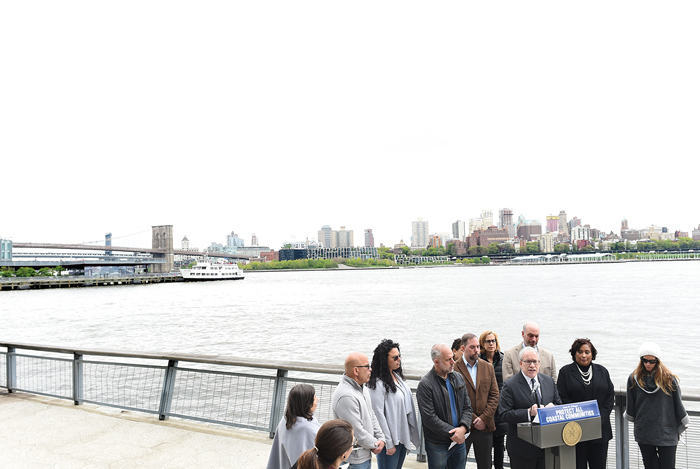File Photo
“The federal government’s decision to abandon the Army Corps’ storm surge study is reckless, and it exposes our region to the ravages of the next superstorm,” City Comptroller Scott Stringer said.
By Michael V. Cusenza
The U.S. Army Corps of Engineers recently acknowledged that it has indefinitely suspended the vital New York-New Jersey Harbor and Tributaries Coastal Storm Risk Management Feasibility Study due to lack of funding.
The analysis focuses on developing measures to manage future flood risk in ways that support the long-term resilience and sustainability of the N.Y.-N.J. coastal ecosystem and surrounding communities, and reduce the economic costs and risks associated with flood and storm events such as Superstorm Sandy.
However, the study lost out to other priorities in the USACE budget, agency spokesman Michael Embrich said in a Newsday report.
New York elected officials on Tuesday blasted the Army Corps—and the White House.
“The administration is being penny-wise and pound-foolish by not funding the studies that allow New Yorkers to prepare for the next superstorm,” U.S. Sen. Chuck Schumer (D-N.Y.) told The Forum. “There was no reason given for these cuts—because there is no answer.”
City Comptroller Scott Stringer said, “The federal government’s decision to abandon the Army Corps’ storm surge study is reckless, and it exposes our region to the ravages of the next superstorm. Climate change is real and New Yorkers can’t afford to have the federal government pretend otherwise. Nothing less than the future of our city is on the line. The Army Corps must conclude its study, put shovels in the ground, and begin the build-out of an integrated and feasible shorefront resiliency system that includes floodwalls, dunes, wetlands, and levees—projects that will actually protect our city.”
This isn’t the first time that Stringer has commented on the study. Last month, he fired off a four-page letter to the USACE condemning its plan to construct offshore storm surge barriers in New York Harbor. In the missive, Stringer castigated the corps’ proposal for not adequately protecting coastal communities from the threat of sea level rise and associated flooding. The comptroller’s letter also highlighted the long construction timeline associated with the storm barriers and their high cost estimate — noting that the largest of the options outlined in the proposal would take a quarter of a century to build out, cost six times that of shorefront resiliency options, and endanger the delicate ecosystem of the harbor including the region’s network of marshes and wetlands that are critical to mitigating storm surge.
Stringer called on the corps to implement an integrated and environmentally-conscious approach that’s focused on onshore resiliency measures including localized floodwalls, dune and wetland restoration, living shorelines, reefs, and levees. Stringer’s message pointed out that this approach was the only way to protect the city from rising sea levels, storm surge from non-catastrophic weather events, and increasingly catastrophic storms in the future.
In October 2012, Superstorm Sandy eviscerated parts of the city, especially Howard Beach, Broad Channel, and the Rockaway Peninsula, leaving 43 fatalities and more than $20 billion in damages in its wake.

